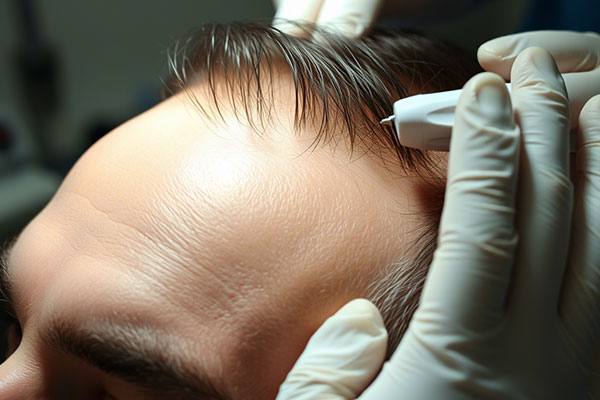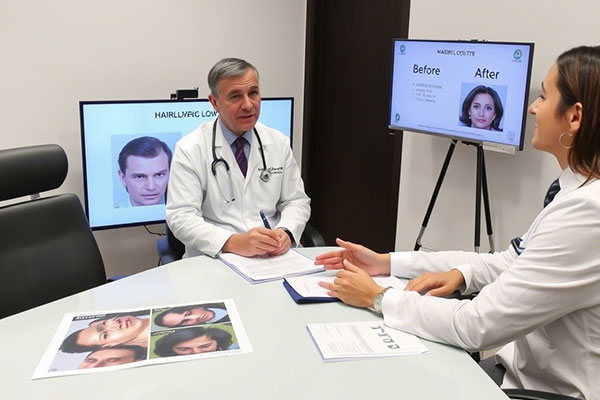Micro FUE Turkey: The Ultimate Guide to Advanced Hair Transplantation in 2025
Discover how Turkey has revolutionized hair restoration with cutting-edge Micro FUE technology, exceptional results, and affordable packages
Are you struggling with hair loss and searching for a permanent, natural-looking solution? You’re not alone. Millions around the world face similar challenges, but advanced technologies like Micro FUE are changing lives with remarkable results.
Hair loss affects not just appearance but can significantly impact self-confidence and mental wellbeing. While various treatments exist, hair transplantation has emerged as the gold standard for permanent restoration, with Micro FUE technology leading the revolution.
Turkey has established itself as a global leader in hair transplantation, combining cutting-edge Micro FUE techniques with affordable packages, making what was once a luxury accessible to many. This comprehensive guide covers everything you need to know about Micro FUE in Turkey – from understanding the procedure and its benefits to costs, recovery, and typical results.
What You’ll Learn in This Guide:
- How Micro FUE technology has revolutionized hair transplantation
- The step-by-step procedure and advanced techniques used
- Pricing comparison between Turkey and European countries
- Recovery timeline and what to expect after treatment
- Real results and success rates backed by medical research
- How to choose the right clinic for your needs
What is Micro FUE Hair Transplantation?
Micro FUE (Follicular Unit Extraction) represents the cutting edge of hair transplant technology. Unlike traditional methods, this minimally invasive technique involves extracting individual hair follicles from a donor area (typically the back of the head) and implanting them precisely where needed to create a natural, fuller appearance.
The “Micro” aspect refers to the use of specialized micro-instruments that allow surgeons to extract and implant follicular units with unprecedented precision, creating tiny incisions that heal quickly and leave virtually invisible scars.

The key innovation of Micro FUE is its ability to harvest hair follicles with minimal trauma to surrounding tissues. This results in quicker healing, less discomfort, and high survival rates for transplanted grafts – leading to fuller, more natural-looking results.
While the procedure is available worldwide, Turkey has become synonymous with excellence in Micro FUE hair transplantation, attracting patients from Europe, the Middle East, and beyond with its combination of specialized expertise, advanced technology, and cost-effective packages.
“Micro FUE has revolutionized hair transplantation by minimizing scarring and maximizing natural-looking results. The precision of this technique allows for more successful graft placement and higher survival rates of transplanted follicles.”
— Journal of Cutaneous and Aesthetic Surgery
Micro FUE vs. Traditional Hair Transplant Methods
Understanding the differences between Micro FUE and earlier hair transplant techniques is crucial for making an informed decision about your treatment. Let’s compare Micro FUE with traditional methods:
| Feature | Micro FUE | Traditional FUE | FUT (Strip Method) |
|---|---|---|---|
| Extraction Method | Individual follicles using micro-punches (0.6-0.8mm) | Individual follicles using standard punches (0.9-1.2mm) | Strip removal from donor area |
| Scarring | Virtually invisible micro-dots | Small, scattered dots | Linear scar across donor area |
| Pain Level | Minimal | Mild to moderate | Moderate to high |
| Recovery Time | 5-7 days | 7-10 days | 2-3 weeks |
| Graft Survival Rate | 95-98% | 90-95% | 85-95% |
| Natural Appearance | Excellent | Very Good | Good |
The key advantages of Micro FUE over traditional methods include:
- Higher precision: Smaller instruments allow for more precise extraction and implantation
- Minimal scarring: Tiny extraction sites leave virtually invisible marks
- Reduced trauma: Less damage to surrounding tissue means faster healing
- Greater comfort: Patients report less post-operative discomfort
- Faster recovery: Most patients return to normal activities within 5-7 days
- No-shave options: Advanced Micro FUE can sometimes be performed without shaving the entire head
Recent studies published in the Journal of Maxillofacial and Oral Surgery highlight that while traditional FUE remains effective, Micro FUE’s refinements have led to significantly improved outcomes in graft survival rates and overall patient satisfaction.
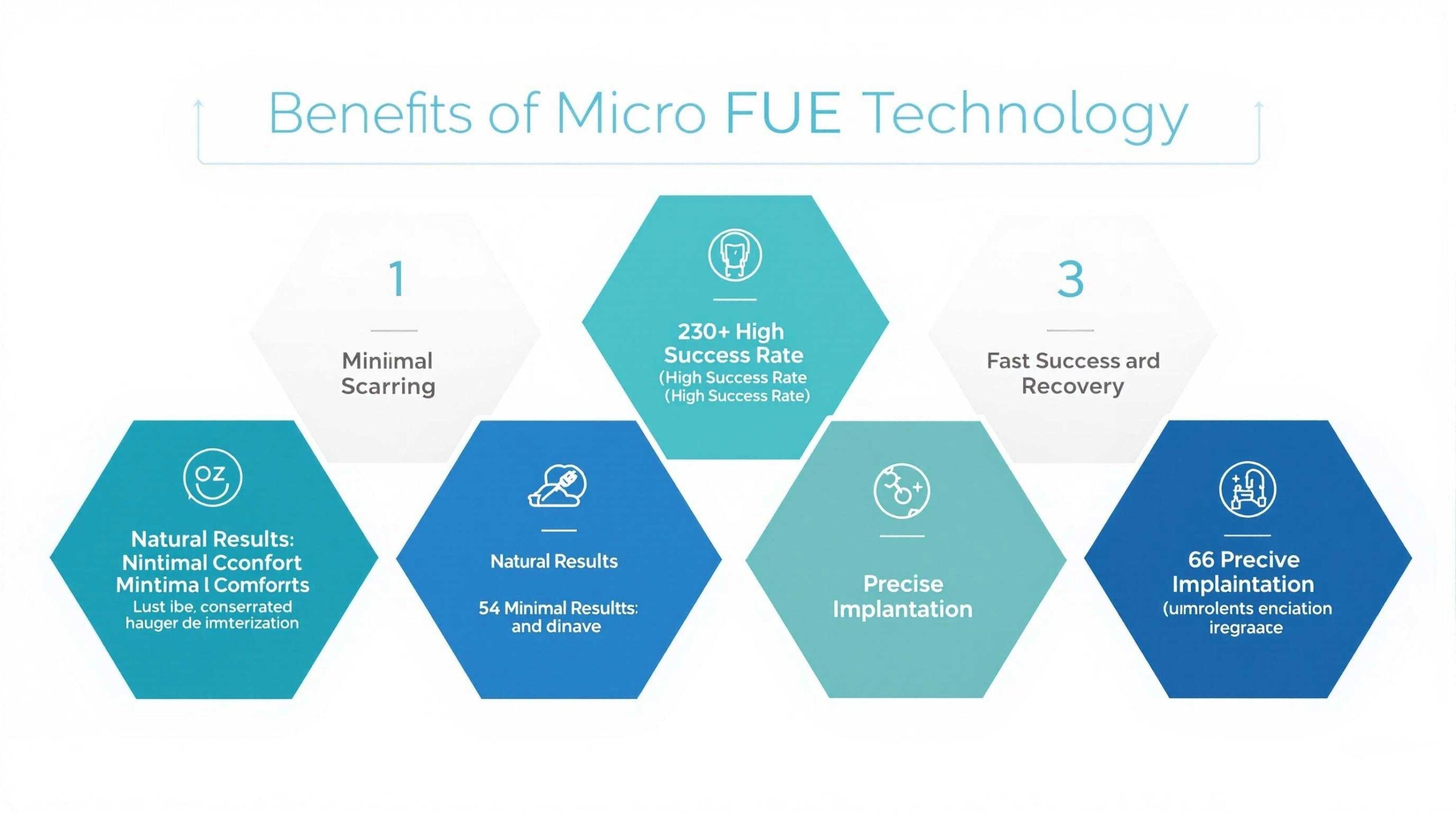
Micro FUE Procedure: Step-by-Step
The Micro FUE procedure in Turkey follows a standardized yet personalized approach to ensure optimal results. Here’s a detailed breakdown of what you can expect:
1. Pre-Operative Consultation
Before the procedure, you’ll undergo a thorough evaluation where the surgeon assesses your hair loss pattern, donor area quality, and discusses your expectations. This crucial step allows for personalized planning, including the number of grafts needed and the design of your new hairline.
2. Preparation
On the day of the procedure, the surgical team prepares both the donor and recipient areas. The donor area (usually the back of the head) is typically trimmed short for easier access, though some clinics offer “no-shave” options for those concerned about visibility during recovery. Local anesthesia is administered to ensure comfort throughout the procedure.
3. Extraction Phase
Using specialized micro-punches (0.6-0.8mm in diameter), the surgeon carefully extracts individual follicular units containing 1-4 hairs from the donor area. These micro-instruments allow for precise extraction with minimal trauma to surrounding tissue. Depending on your needs, anywhere from 1,500 to 4,500 grafts may be harvested in a single session.
4. Graft Preparation
Once extracted, the follicular units are carefully prepared and sorted based on the number of hairs they contain. This meticulous process ensures optimal placement for a natural-looking result. The grafts are kept in a special solution to maintain their viability until implantation.
5. Recipient Site Creation
The surgeon creates tiny incisions in the recipient area, carefully considering the direction, angle, and density of your natural hair growth pattern. This artistry is crucial for achieving natural-looking results. Many Turkish clinics now use sapphire blades for this step, which create cleaner incisions that heal faster.
6. Graft Implantation
The prepared follicular units are delicately implanted into the created incisions. Single-hair follicular units are typically placed along the hairline for a natural appearance, while multi-hair units are placed behind to create density. This strategic placement is key to achieving natural-looking results.
7. Post-Operative Care
After the procedure, you’ll receive detailed care instructions, medication for comfort, and special shampoo for gentle cleaning. Most clinics in Turkey include overnight accommodation and follow-up care as part of their packages.
The entire procedure typically takes 6-8 hours, depending on the number of grafts being transplanted. Thanks to local anesthesia, patients remain comfortable throughout the process, often watching movies or napping during the procedure.
Advanced Variations:
Many Turkish clinics now offer enhanced versions of Micro FUE, including:
- Sapphire Micro FUE: Uses sapphire blades for even finer recipient site creation
- DHI (Direct Hair Implantation): Uses a specialized pen-like instrument to create sites and implant grafts in one step
- Needle-Free Anesthesia: Pressure-based systems for delivering anesthesia without needles
Micro FUE Costs: Turkey vs. Europe
One of the primary reasons Turkey has become a global hub for hair transplantation is the significant cost advantage it offers compared to clinics in Western Europe and North America. This cost difference does not reflect a compromise in quality but rather results from lower operational costs and a competitive market.
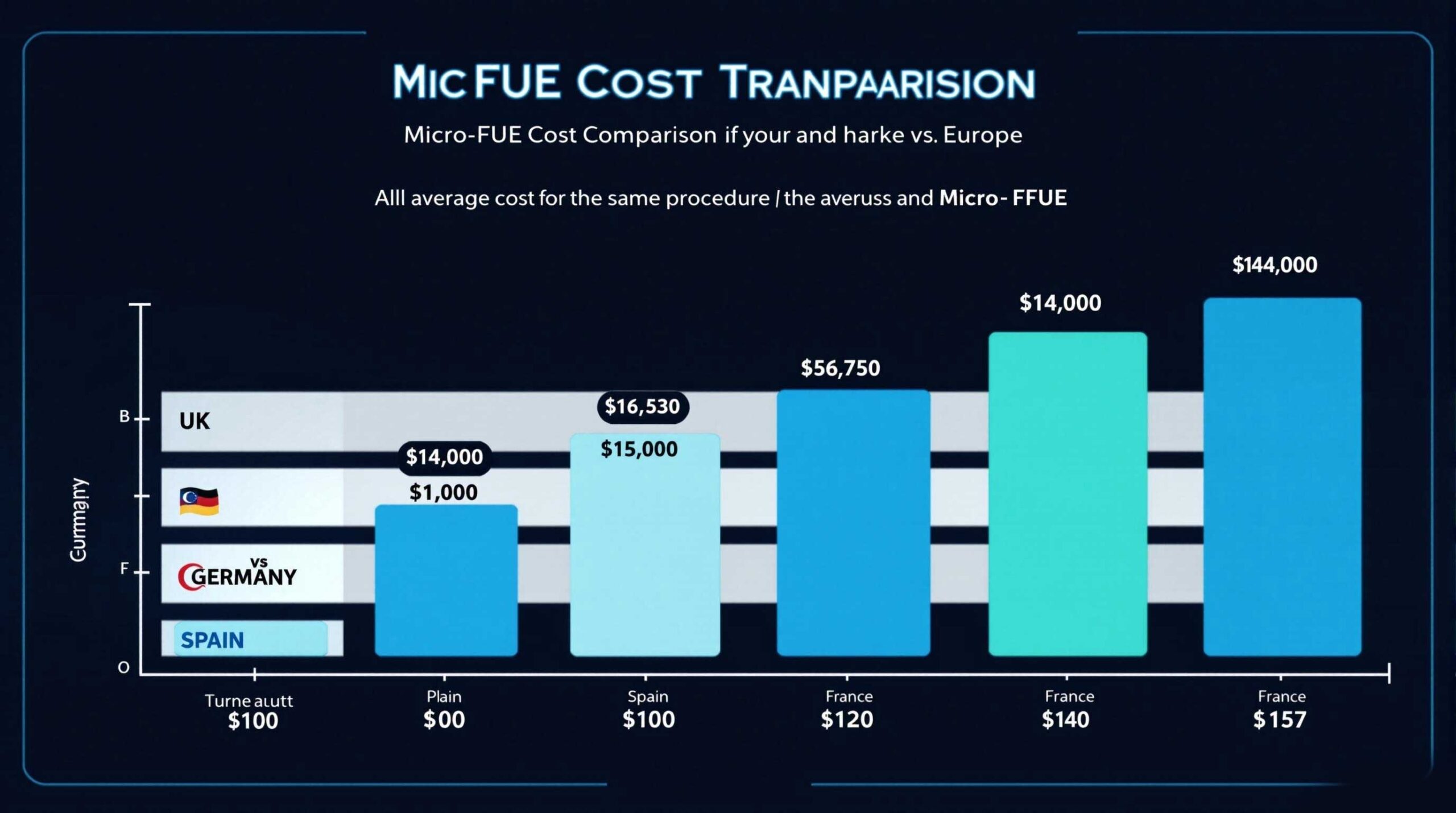
The average cost of a Micro FUE hair transplant in Turkey ranges from $1,800 to $4,500, depending on the clinic’s reputation, surgeon expertise, and the number of grafts required. This typically includes not just the procedure itself, but a comprehensive package covering:
- Free consultation and treatment planning
- The Micro FUE procedure (up to 4,000-5,000 grafts)
- Medications and aftercare products
- Airport transfers in Istanbul
- 2-3 nights accommodation at a partner hotel
- Translator services if needed
- Post-operative follow-up care
In comparison, the same procedure in countries like the UK, Germany, or France would cost between $10,000 and $25,000, without including accommodation or transfers.
| Package Type | What’s Included | Average Price in Turkey |
|---|---|---|
| Standard Micro FUE | Up to 4,000 grafts, basic accommodation, transfers | $1,800 – $2,400 |
| Premium Micro FUE | Up to 4,500 grafts, 4-star hotel, VIP transfers, PRP therapy | $2,500 – $3,200 |
| VIP Micro FUE | Up to 5,000 grafts, 5-star hotel, private transfers, PRP, stem cell therapy | $3,300 – $4,500 |
| Sapphire Micro FUE | Enhanced technique using sapphire blades, premium package inclusions | $2,400 – $3,500 |
| DHI Micro FUE | Direct implantation technique, premium package inclusions | $2,700 – $4,000 |
It’s important to note that while price is a significant factor, it shouldn’t be the only consideration. The surgeon’s expertise, clinic reputation, and proven results should always take precedence when making your decision.
Why Turkey Offers Better Value:
- Lower operational costs and overhead expenses
- Government incentives for medical tourism
- Competitive market with many specialized clinics
- Favorable exchange rates for international patients
- Package deals that include non-medical expenses
Despite the lower costs, Turkish clinics often use the same or even more advanced equipment than their European counterparts, with many surgeons having international training and certification.
For more information about medical treatments and their costs in Turkey, you can explore comprehensive guides and package options.
Results and Success Rates
The effectiveness of Micro FUE hair transplantation in Turkey is backed by impressive success rates and countless before-and-after transformations. Understanding what results you can expect is crucial for setting realistic expectations.

According to clinical studies and patient data from leading Turkish clinics, Micro FUE procedures have a graft survival rate of 95-98%, significantly higher than older transplantation methods. This high success rate translates to natural-looking, long-lasting results for the vast majority of patients.
A recent study published in BMC Surgery examined the outcomes of FUE hair transplantation in treating male androgenetic alopecia and found that “over 90% of the hair follicles survived in 158 patients, with more than 85% of patients achieving a hair density rating of 3-4 on a 5-point scale.”
While results vary based on individual factors such as hair type, donor area quality, and the extent of hair loss, most patients can expect:
- Natural-looking hairline design tailored to facial features and age
- Consistent growth pattern matching existing hair
- Permanent results (transplanted hair is resistant to DHT, the hormone responsible for pattern baldness)
- Improved density in previously thinning areas
- Enhanced overall appearance and restored confidence
“I had almost given up hope after trying various medications without success. My Micro FUE procedure in Istanbul changed everything. It’s been 14 months since my procedure, and the results are better than I ever imagined. The natural look of my hairline has given me back my confidence.”
— James, 38, from Manchester
It’s important to note that hair transplant results take time to fully manifest. The transplanted follicles typically shed within 2-4 weeks after the procedure, which is normal and expected. New growth begins around 3-4 months post-procedure, with final results visible after 12-18 months.
For those interested in other aesthetic procedures in Turkey, you can learn more about cosmetic dental procedures that can complement your new look.
Recovery and Timeline
Understanding the recovery process and timeline after a Micro FUE procedure is essential for planning your treatment and setting realistic expectations. The good news is that Micro FUE offers a significantly faster and more comfortable recovery compared to traditional hair transplant methods.
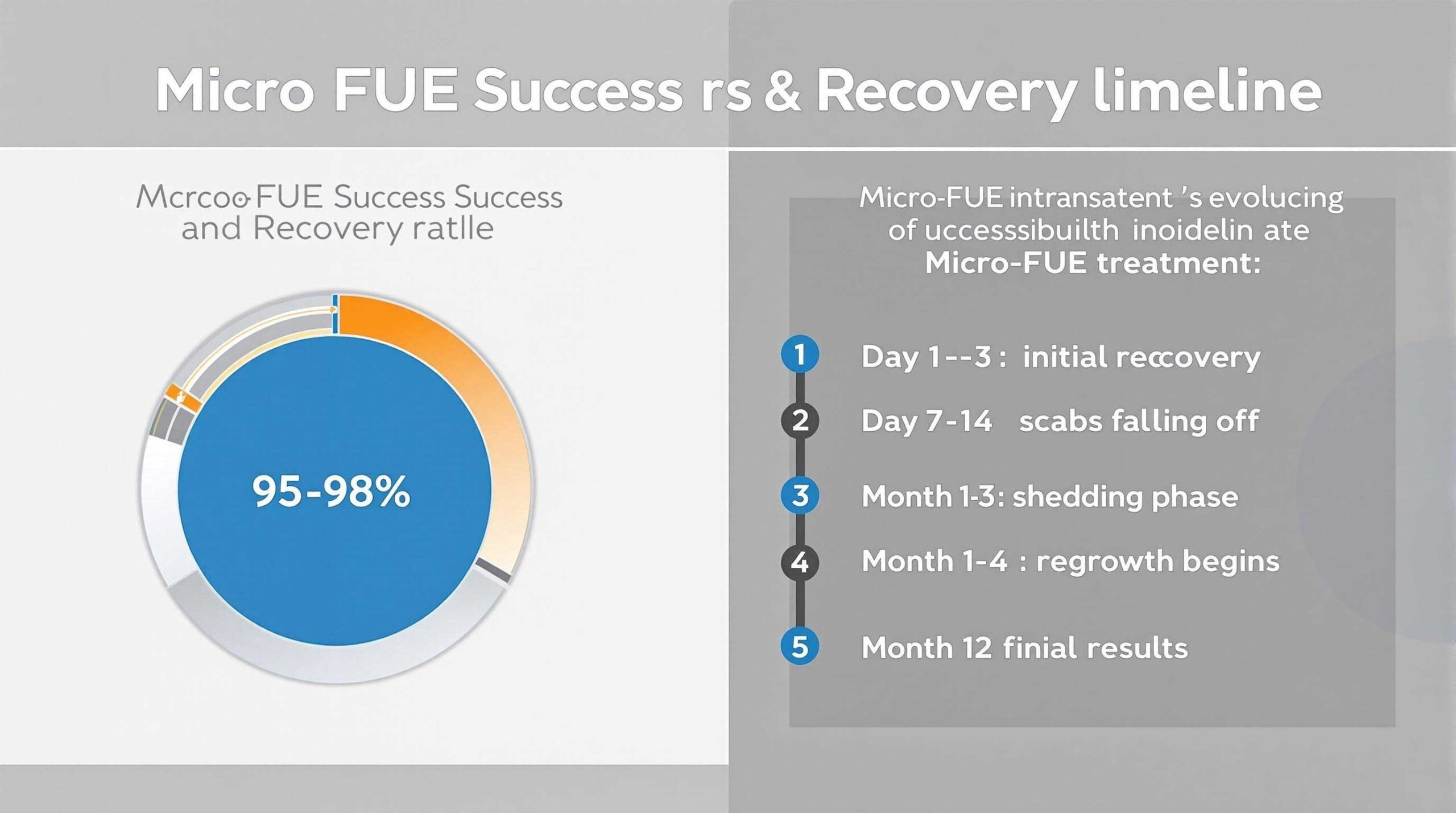
Days 1-3: Initial Recovery
Expect some redness, swelling, and mild discomfort in both donor and recipient areas. You’ll need to sleep with your head elevated and avoid touching the transplanted area. Most clinics provide special shampoo and detailed washing instructions for this period.
Days 4-7: Reduced Swelling
Swelling typically subsides, though tiny crusts form around each transplanted follicle. Most patients can return to light activities and non-strenuous work. Continue following the special washing protocol provided by your clinic.
Days 7-14: Scabs Fall Off
The crusts/scabs begin to fall off naturally. The donor area starts healing more visibly. You can gradually return to normal washing routines, though gentle care is still recommended. Most visible signs of the procedure fade during this period.
Weeks 2-4: Shedding Phase
The “shock loss” phase begins, where transplanted hairs shed. This is completely normal and part of the healing process. The follicles remain healthy beneath the skin and will regrow. You can resume most normal activities, including gentle exercise.
Months 3-4: Initial Growth
The first new hairs begin to emerge from the transplanted follicles. Growth is still thin and patchy at this stage. Donor area is completely healed with minimal visible scarring. You can resume all normal activities, including swimming and intense exercise.
Months 6-9: Increased Density
Hair growth accelerates, with noticeable improvements in density and coverage. The new hair begins to thicken and match your existing hair texture. Most patients see significant improvement at this stage, though results continue to improve.
Months 12-18: Final Results
The transplanted hair reaches full maturity, with maximum thickness and density achieved. The hairline and crown area appear natural and fully integrated with existing hair. The final result is a permanent, natural-looking restoration of your hair.
Post-Procedure Care Tips:
- Follow your surgeon’s washing instructions precisely
- Avoid direct sun exposure for at least 3 months
- Don’t wear hats or caps that put pressure on the transplanted area for 2 weeks
- Sleep with your head elevated for the first week
- Avoid strenuous exercise for 2-3 weeks
- Don’t consume alcohol or smoke for at least 7 days post-procedure
- Take prescribed medications and supplements as directed
Most Turkish clinics provide comprehensive aftercare instructions and support throughout the recovery period, with virtual follow-up consultations to monitor your progress remotely after you return home.
For more information about the quality of medical care and services available in Turkey, you can explore treatment options in Istanbul and what makes it a preferred destination for international patients.
How to Choose the Right Clinic in Turkey
With hundreds of clinics offering Micro FUE in Turkey, selecting the right one for your procedure is crucial. Here are key factors to consider when making this important decision:
1. Surgeon Credentials and Specialization
Look for clinics with board-certified surgeons who specialize in hair transplantation, particularly Micro FUE. Check their educational background, years of experience, and whether they’re members of international hair restoration societies such as the International Society of Hair Restoration Surgery (ISHRS).
2. Before and After Gallery
Review extensive before and after photos of previous patients with similar hair loss patterns to yours. Legitimate clinics should have a substantial portfolio showcasing their work from various angles and lighting conditions. Be wary of clinics that only show a few perfect results.
3. Patient Reviews and Testimonials
Read independent reviews on platforms like Trustpilot, RealSelf, or hair loss forums. Look for detailed accounts of patients’ experiences, including communication with the clinic, the procedure itself, and long-term results. Pay attention to how the clinic handles any complications or concerns.
4. Clinic Facilities and Technology
Top clinics should have modern, sterile facilities with the latest equipment. Ask about the specific technologies they use for Micro FUE, such as motorized extraction devices, sapphire blades, or specialized implantation tools. Virtual tours of the facility can be helpful in assessing standards.
5. Personalized Approach
Avoid clinics that offer one-size-fits-all solutions. Each patient’s hair loss pattern, donor area quality, and aesthetic goals are unique. The best clinics provide personalized assessments, including scalp analysis and custom treatment plans tailored to your specific needs.
6. Transparency in Pricing
Reputable clinics should provide clear, detailed pricing with no hidden fees. Be skeptical of prices that seem too good to be true – they often indicate shortcuts in quality or safety. Also, ensure the quote includes all services mentioned in their package.
7. Post-Procedure Support
Hair transplantation is a journey, not just a one-day procedure. Choose clinics that offer comprehensive aftercare, including detailed instructions, follow-up consultations, and support for any concerns that arise during recovery.
Red Flags to Watch For:
- Clinics that guarantee specific results (no ethical surgeon can promise exact outcomes)
- Extremely low prices compared to the market average
- Pressure to make immediate decisions without proper consultation
- Lack of information about the performing surgeon
- Refusal to provide direct contact with your surgeon before booking
- Vague responses to specific technical questions
Taking time to research thoroughly and communicate directly with potential clinics will significantly increase your chances of a successful procedure and satisfying results.
For more insights about medical services in Turkey, explore comprehensive guides about medical treatments and what makes the country a preferred destination for international patients.
Frequently Asked Questions
Is Micro FUE hair transplantation painful?
Micro FUE is performed under local anesthesia, making the procedure itself virtually painless. Some patients report mild discomfort during the administration of anesthesia. Post-procedure discomfort is typically minimal and well-managed with standard pain relievers for 1-2 days.
How long do I need to stay in Turkey for a Micro FUE procedure?
Most clinics recommend staying 3-4 days in total. This typically includes one day for pre-operative consultation, one day for the procedure, and 1-2 days for initial recovery and a follow-up check before returning home.
Will people be able to tell I’ve had a hair transplant?
During the initial healing phase (7-10 days), there will be visible signs of the procedure, such as redness and tiny scabs. Most patients wear loose hats or take a short vacation during this period. Once healed, a properly performed Micro FUE transplant should be undetectable, creating a natural-looking result that blends seamlessly with your existing hair.
Does transplanted hair fall out again?
Hair transplanted through Micro FUE is typically taken from the back and sides of the head, where follicles are genetically resistant to the hormones that cause male pattern baldness. This means the transplanted hair usually retains this resistance and grows permanently in its new location. However, existing (non-transplanted) hair may continue to thin over time.
How many grafts will I need?
The number of grafts needed depends on several factors, including the extent of hair loss, the density you wish to achieve, and the quality of your donor area. For reference:
- Frontal hairline restoration: 1,500-2,000 grafts
- Crown coverage: 1,000-2,000 grafts
- Significant baldness (Norwood 5-6): 3,000-5,000 grafts
A proper consultation with hair analysis is necessary for an accurate assessment.
Is it safe to have a hair transplant in Turkey?
Turkey’s top hair transplant clinics adhere to international medical standards and safety protocols. Many leading clinics have international accreditations and surgeons trained in Europe or the United States. As with any medical procedure, the key is to choose a reputable clinic with certified professionals and proven results. Thorough research is essential to ensure safety and quality.
Can women undergo Micro FUE procedures?
Yes, Micro FUE is suitable for women experiencing certain types of hair loss, particularly those with localized thinning or specific areas of concern. Women typically require different hairline designs and density patterns compared to men. A specialized consultation is important to determine if Micro FUE is the appropriate solution for female pattern hair loss.
Conclusion: Is Micro FUE in Turkey Right for You?
Micro FUE hair transplantation in Turkey represents a remarkable convergence of advanced medical technology, artistic skill, and cost-effectiveness that has transformed the lives of countless individuals struggling with hair loss.
The procedure offers numerous advantages over traditional hair restoration methods, including minimal scarring, faster recovery, and exceptionally natural-looking results. When performed by qualified professionals in reputable Turkish clinics, Micro FUE provides a permanent solution to hair loss with success rates of 95-98%.
The significant cost savings – often 60-70% less than Western European or North American prices – makes this advanced treatment accessible to many who would otherwise be unable to afford it. This, combined with Turkey’s established infrastructure for medical tourism, explains why over 100,000 patients travel to the country annually for hair restoration procedures.
However, as with any medical procedure, thorough research is essential. The key to a successful outcome lies in selecting a reputable clinic with qualified surgeons, proven results, and comprehensive aftercare. By taking time to investigate your options, communicate directly with potential providers, and set realistic expectations, you can maximize your chances of achieving the transformative results you desire.
Whether you’re in the early stages of hair loss or have been considering a transplant for years, Micro FUE in Turkey offers a compelling combination of quality, affordability, and results that has established the country as the global leader in hair restoration.
Ready to take the next step? Explore your options, arrange virtual consultations with leading clinics, and begin your journey toward renewed confidence and a natural-looking, full head of hair.
For more information about medical treatments in Turkey, including cosmetic procedures and dental treatments, explore our comprehensive guides.
Learn More About Micro FUEScientific References
- Wang F, Chen Y, Yang C, et al. (2024). Using the follicular unit extraction technique in treatment of male androgenetic alopecia. BMC Surgery. https://link.springer.com/article/10.1186/s12893-024-02655-1
- Dua A, Dua K. (2010). Follicular unit extraction hair transplant. Journal of Cutaneous and Aesthetic Surgery. https://journals.lww.com/jcas/fulltext/2010/03020/follicular_unit_extraction_hair_transplant.3.aspx
- Sharma R, Ranjan A. (2019). Follicular unit extraction (FUE) hair transplant: curves ahead. Journal of Maxillofacial and Oral Surgery. https://link.springer.com/article/10.1007/s12663-019-01245-6
- Bicknell LM, Kash N, Kavouspour C, et al. (2014). Follicular unit extraction hair transplant harvest: a review of current recommendations and future considerations. Dermatology Online Journal. https://escholarship.org/uc/item/1954f4vv
- Navarro RM, Pino A, Martinez-Andres A, et al. (2018). The effect of plasma rich in growth factors combined with follicular unit extraction surgery for the treatment of hair loss: A pilot study. Journal of Cosmetic Dermatology. https://onlinelibrary.wiley.com/doi/abs/10.1111/jocd.12446


